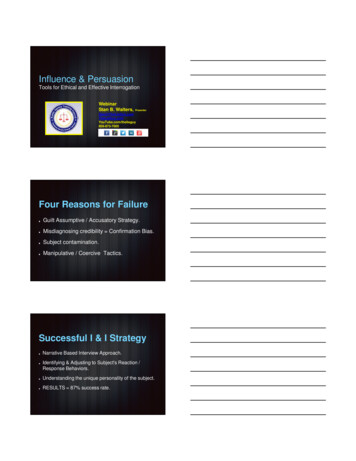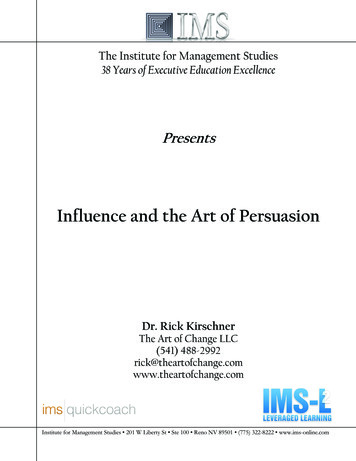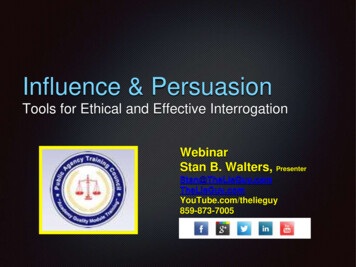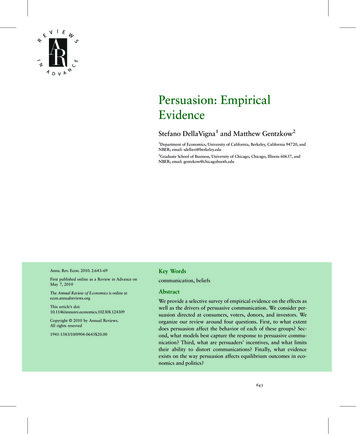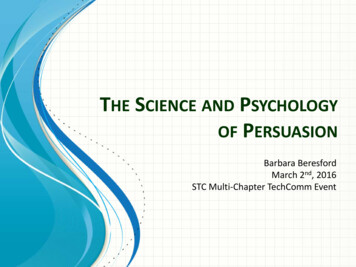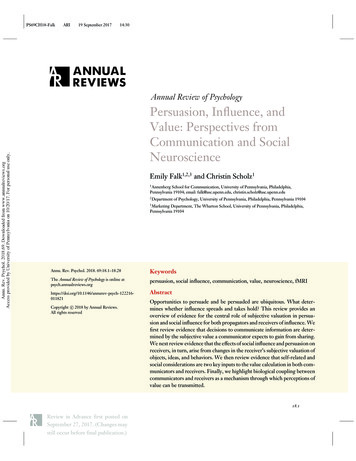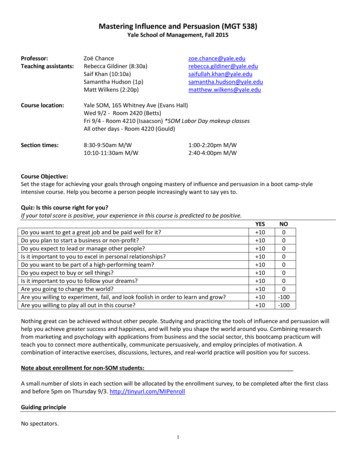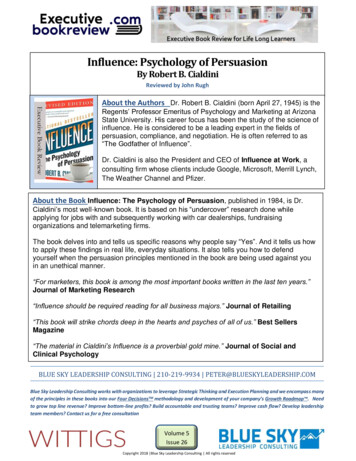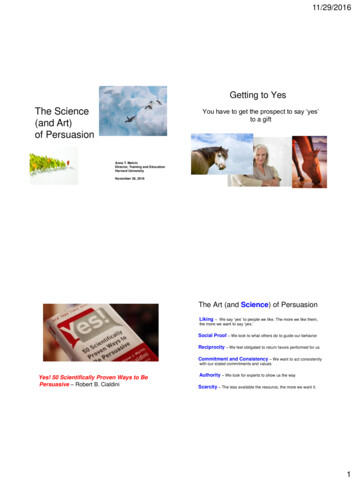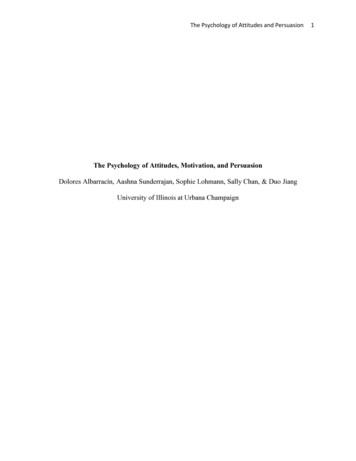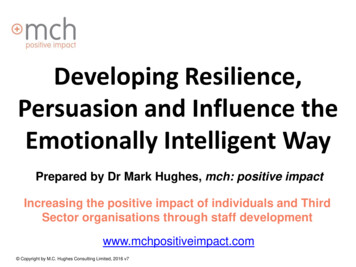
Transcription
Developing Resilience,Persuasion and Influence theEmotionally Intelligent WayPrepared by Dr Mark Hughes, mch: positive impactIncreasing the positive impact of individuals and ThirdSector organisations through staff developmentwww.mchpositiveimpact.com Copyright by M.C. Hughes Consulting Limited, 2016 v7
2
Overview of SessionPersuasion3
Overview of SessionPersuasion6 Universal Principles4
Overview of SessionPersuasionVersusInfluence6 Universal Principles5
Overview of SessionPersuasion6 Universal PrinciplesVersusInfluenceTrust6
Overview of SessionPersuasion6 Universal PrinciplesVersusInfluenceTrustEmotional Intelligence7
Overview of SessionPersuasionVersusInfluence6 Universal PrinciplesTrustEmotional IntelligenceResilience8
Overview of SessionPersuasionVersusInfluence6 Universal PrinciplesTrustEmotional IntelligenceResilience9
Overview of SessionPersuasionVersusInfluence10
Similarities between Persuasion and InfluenceAim of Both:To make someonethink, feel or act in aparticular way11
Similarities between Persuasion and InfluenceAim of Both:To impact ondecision making12
How Decisions are MadeWhile decisions may bejustified with logic, theyare invariably driven byemotion.The Feeling Of What Happens: Body, Emotion and the Making of Consciousness, Antonio Damasio13
How Decisions are MadeREDUCEBADINCREASEGOOD14
How Decisions are urity15
How Decisions are ltyInsecuritySafety HappinessEgoStuff!Egoi.e.Greed16
How Decisions are REASEBAD&GOODPleasureSafety HappinessEgoStuff!Egoi.e.Greed17
Persuading othersinvolves working outhow you canreduce the ‘bad’ and/orincrease the ‘good’18
"The best move you canmake is to think of anincentive the otherperson hasn't eventhought of - and thenmeet it."Eli Broad, Entrepreneur & Philanthropist
Overview of SessionPersuasion6 Universal Principles20
Universal Principles for Persuasion1.ReciprocityBased on research by Robert Cialdini and Steve Martin. For a visual summary see:https://www.youtube.com/watch?v cFdCzN7RYbw21
Reciprocity and the Mint Study22
Reciprocity and the Mint StudyKey Take-Aways: Be the first to give Personalise it Make itunexpected23
Charitable Case Study24
Percentage of Employees that Donated a Day’s SalaryGenericEmailPersonalisedEmail fromCEO5%12%25
Percentage of Employees that Donated a Day’s SalaryGenericEmailPersonalisedEmail from CEO5%12%Receipt of aBranded Sweetfrom a Volunteerbefore Request26
Percentage of Employees that Donated a Day’s SalaryGenericEmail5%12%PersonalisedEmail from CEOReceipt of aBranded Sweetfrom a Volunteerbefore RequestCited on Positive Studio website. sonalisedEmail from CEO17%27
Universal Principles for Persuasion1.Reciprocity2.ScarcityBased on research by Robert Cialdini and Steve Martin. For a visual summary see:https://www.youtube.com/watch?v cFdCzN7RYbw28
Scarcity and Concorde29
Scarcity and ConcordeHighlights impact ofstressing: What you stand tolose Uniqueness30
Universal Principles for Persuasion1.Reciprocity2.Scarcity3.AuthorityBased on research by Robert Cialdini and Steve Martin. For a visual summary see:https://www.youtube.com/watch?v cFdCzN7RYbw31
Impact of Testimonials
Impact of Testimonials20% moreappointments15% morecontracts signed33
Impact of TestimonialsLet me put youthrough to ourlettings team.20% moreappointments15% morecontracts signed34
Impact of TestimonialsLet me put youthrough to ourlettings team.Let me put youthrough to Bill in ourlettings team. Hehas over 10 years ofexperience in lettingproperties in yourarea.20% moreappointments15% morecontracts signed35
Who Can Give Youan Introductionwhich Testifies toYour Credibility?36
Universal Principles for istencyBased on research by Robert Cialdini and Steve Martin. For a visual summary see:https://www.youtube.com/watch?v cFdCzN7RYbw37
Consistency – The Stepping Stone Approach38
Consistency – The Stepping Stone Approach39
Universal Principles for istency5.ConsensusBased on research by Robert Cialdini and Steve Martin. For a visual summary see:https://www.youtube.com/watch?v cFdCzN7RYbw40
Consensus and LegaciesBaseline for Legacies4.9%41
Consensus and LegaciesBaseline for Legacies4.9%“Would you like to leaveany money to charity inyour will?”10.4%42
Consensus and LegaciesBaseline for Legacies4.9%“Would you like to leaveany money to charity inyour will?”10.4%“Many of our clients like to leavemoney to charity in their will. Are thereany causes you are passionate about?”Based on research conducted by the UK Government’s Cabinet Office Behavioural Insights Team15.4%43
Universal Principles for istency5.Consensus6.LikingBased on research by Robert Cialdini and Steve Martin. For a visual summary see:https://www.youtube.com/watch?v cFdCzN7RYbw44
Making People Like YouSimilarities&Compliments45
Business School Negotiation ExerciseTime Money55% reachedagreement46
Business School Negotiation ExerciseTime Money55% reachedagreementFind outsomething youhave in commonbefore negotiating90% reachedagreementAgreement worth18% more to bothparties47
What are OtherWays to BuildRapport?48
What is the learning style of the person you’re trying topersuade?Activists Like to take direct action/Primarily interested in the here and nowThink on their feetPrefer short sessions and plenty of varietyLike opportunities to initiate, participate and have fun49
What is the learning style of the person you’re trying topersuade?Activists Like to take direct action/Primarily interested in the here and nowThink on their feetPrefer short sessions and plenty of varietyLike opportunities to initiate, participate and have funTheorists Like to learn based on proven concepts and modelsThink analytically and logicallyPrefer a sequential approach to problemsLike structure and logical presentation
What is the learning style of the person you’re trying topersuade?Activists Like to take direct action/Primarily interested in the here and nowThink on their feetPrefer short sessions and plenty of varietyLike opportunities to initiate, participate and have funTheorists Like to learn based on proven concepts and modelsThink analytically and logicallyPrefer a sequential approach to problemsLike structure and logical presentationPragmatists Like to see how things workThink in practical termsPrefer to see the relevance of their work/learningLike activities to be real51
What is the learning style of the person you’re trying topersuade?Activists Like to take direct action/Primarily interested in the here and nowThink on their feetPrefer short sessions and plenty of varietyLike opportunities to initiate, participate and have funTheorists Like to learn based on proven concepts and modelsThink analytically and logicallyPrefer a sequential approach to problemsLike structure and logical presentationPragmatists Like to see how things workThink in practical termsPrefer to see the relevance of their work/learningLike activities to be realReflectors Like to think about things in detail before taking actionLike thorough preparationPrefer to make decisions in their own timeLike to listen, observe and evaluateBased on Honey and Mumford Learning Styles Model52
Universal Principles for istency5.Consensus6.LikingBased on research by Robert Cialdini and Steve Martin. For a visual summary see:https://www.youtube.com/watch?v cFdCzN7RYbw53
Which principlewould work best onthe person youwant to persuade?54
Universal Principles for istency5.Consensus6.LikingBased on research by Robert Cialdini and Steve Martin. For a visual summary see:https://www.youtube.com/watch?v cFdCzN7RYbw55
PersuasionVsInfluence56
Differences between Persuasion and n57
Differences between Persuasion and nfluenceReputationCrucial58
Keys to Trust59
Keys to TrustRELIABILITY60
Keys to TrustRELIABILITYACCEPTANCE61
Keys to TrustRELIABILITYACCEPTANCEOPENNESS62
Keys to TrustRELIABILITYACCEPTANCEOPENNESSCONGRUENCE63
Which key to trustdo you need todevelop?64
Overview of SessionPersuasion6 Universal PrinciplesVersusInfluenceTrustEmotional Intelligence65
Daniel Goleman and Emotional Intelligence66
Daniel Goleman’s View on Emotional IntelligenceEmotional IntelligenceThe capacity for recognising our own feelings and those ofothers, for motivating ourselves and for managing emotionswell in ourselves and in our relationshipsGoleman, Daniel. (1995) “Emotional Intelligence." Bloomsbury, New York67
Daniel Goleman’s View on Emotional IntelligenceEmotional g your emotions and the effect they have on others68Goleman, Daniel. (1995) “Emotional Intelligence." Bloomsbury, New York
Daniel Goleman’s View on Emotional IntelligenceEmotional IntelligenceSelf-regulationControlling disruptive moods and thinking before actingSelf-awarenessGoleman, Daniel. (1995) “Emotional Intelligence." Bloomsbury, New York69
Daniel Goleman’s View on Emotional IntelligenceEmotional IntelligenceMotivationPursuing goals with an energy/persistence that go beyond money or statusSelf-regulationSelf-awarenessGoleman, Daniel. (1995) “Emotional Intelligence." Bloomsbury, New York70
Daniel Goleman’s View on Emotional IntelligenceEmotional IntelligenceEmpathyTreating people according to their emotional n, Daniel. (1995) “Emotional Intelligence." Bloomsbury, New York71
Daniel Goleman’s View on Emotional IntelligenceEmotional IntelligenceSocial SkillsBuilding rapport and managing effective awarenessGoleman, Daniel. (1995) “Emotional Intelligence." Bloomsbury, New York72
Daniel Goleman’s View on Emotional IntelligenceEmotional IntelligenceThe capacity for recognising our own feelings and those ofothers, for motivating ourselves and for managing emotionswell in ourselves and in our relationshipsSocial SkillsBuilding rapport and managing effective relationshipsEmpathyTreating people according to their emotional stateMotivationPursuing goals with an energy/persistence that go beyond money or statusSelf-regulationControlling disruptive moods and thinking before actingSelf-awarenessRecognising/understanding your emotions and the effect they have on others73Goleman, Daniel. (1995) “Emotional Intelligence." Bloomsbury, New York
Overview of SessionPersuasion6 Universal PrinciplesVersusInfluenceTrustEmotional IntelligenceResilience74
Building ResilienceChoose your reality75
We Choose a Tiny Percentage of Reality11 million pieces ofinformation/secondBrains processes 40 bits/secondManfred Zimmermann, ‘Neurophysiology of Sensory Systems’, in Fundamentals of Sensory Physiology, R. F. Schmidt, 198676
Building ResilienceChoose your realityChoose the meaning yougive to your reality77
Perceptions of Stress78
Perceptions of StressGroup 1 showna factual videoon the positiveimpact of stress79
Perceptions of StressGroup 1 showna factual videoon the positiveimpact of stressGroup 2 showna factual videoon the negativeimpact of stress80
Perceptions of StressGroup 1 showna factual videoon the positiveimpact of stressGroup 2 showna factual videoon the negativeimpact of stressOne weeklater, group1 showed a23% drop inphysicalsymptomsof stressand a 30%increase inproductivityrelative togroup 281
Perceptions of StressGroup 1 showna factual videoon the positiveimpact of stressGroup 2 showna factual videoon the negativeimpact of stressDetailed in ‘Before Happiness’, by Shawn AchorOne weeklater, group1 showed a23% drop inphysicalstresssymptomsand a 30%increase inproductivityrelative togroup 2Stress isinevitablebut itsnegativeeffectsare not82
Building ResilienceChoose your realityChoose the meaning yougive to your realityStay present83
Stress Only Exists in the Past or Future84
Stress Only Exists in the Past or Future Self-talk85
Hard-line Approach to Addressing Negative Self-TalkSUMOShut Up Move On86
Stress Only Exists in the Past or Future Self-talk Mindfulness/Meditation87
Stress Only Exists in the Past or Future Self-talk Mindfulness/Meditation“Paying attention, in a particular way,on purpose, in the present momentand non-judgementally.”Dr Jon Kabat-Zinn, Minfulness Researcher88
Building ResilienceChoose your realityChoose the meaning yougive to your realityStay presentStay healthy89
Emotions do not Exist in a Vacuum – Adopt the ASICSLogo90
Emotions do not Exist in a Vacuum – Adopt the ASICSLogoAnima Sana InCorpore Sano91
Emotions do not Exist in a Vacuum – Nurturing andSustaining Relationships92
Emotions do not Exist in a Vacuum – Nurturing andSustaining RelationshipsIt’s 5am and you’re stuck in Aberdeen.Who would you call?93
What are yougoing to try toimprove yourresilience?94
Building ResilienceChoose your realityChoose the meaning yougive to your realityStay presentStay healthy95
Overview of SessionPersuasionVersusInfluence6 Universal PrinciplesTrustEmotional IntelligenceResilience96
Thank you and allthe best!Mark act.com97
Appendix 1: Mindfulness and Meditation ace98
Similarities between Persuasion and Influence 11 Aim of Both: To make someone think, feel or act in a particular way . Similarities between Persuasion and Influence 12 Aim of Both: . Based on research by Robert Cialdini and Steve Martin. For a visual summary see:
